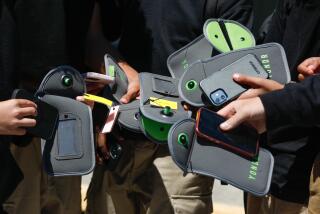Young and Wireless
- Share via
When Tess Jablon heads over the hill this fall from Encino to a private West Hollywood high school, she will be packing an astonishing amount of electronic firepower--all in the palms of her hands.
The 14-year-old’s $179 VTech Helio, a junior-set version of the wildly popular Palm Pilot hand-held organizer, is as powerful as most desktop computers were three years ago. And her new Nokia cellular phone could render her pager obsolete.
Tess can thus lay claim to a spot in the most plugged-in, gadget-happy generation in history. As kids head back to school, many are pleading to have the latest high-tech accouterments to tuck into their backpacks.
Many of these gadgets are extensions of desktop computers at home. A few--notably scientific calculators and laptop computers--have a clear educational use. Most other devices exist primarily to ease family communication or simply to entertain, though proponents say that students pick up valuable high-tech skills as they fiddle with the functions.
Gadget-hungry offspring depend, for the most part, on the kindness of parents to satisfy their cravings for RAM and ROM. Wireless organizers, laptops, digital cameras, CD “burners” for making custom CDs and MP3 music players (think online music pirates Napster and Gnutella) don’t come cheaply.
“Our products are definitely popular with kids,” said Allen Bush, a spokesman for Handspring Inc., the Silicon Valley maker of Visor hand-held organizers. “But they’re not something you could save your paper route money for.”
Nor are these gizmos something that schools and teachers necessarily welcome, though parents have embraced them as ways of getting in touch in emergencies with on-the-go children.
Many of the devices, in fact, are prohibited under the California state Education Code. The bans on electronic listening and recording devices and paging and signaling equipment date to the 1970s and 1980s, when early-generation gadgets were implicated in drug dealing and teachers envisioned annoying disruptions in classrooms.
As devices unthought of in those technological dark ages have proliferated, some schools have chosen to look away. Still, it is the rare, supremely confident teacher who would embrace the new micro Eyemodule camera. The device, which attaches to a Handspring Visor hand-held organizer, can snap a digital shot of the teacher and download it into a computer.
“The abilities of the technology have leapfrogged beyond the intent of the legislation,” said Doug Stone, a spokesman for the California Department of Education. “It’s up to districts to determine what they’re willing to allow and where they draw the line.”
In teacher James Berger’s classroom at Dorsey High School, that line is crossed if, after a warning, students persist in letting their beepers sound rather than vibrate.
“I don’t want to get into grabbing things out of kids’ pockets,” said Berger, who heads the social sciences department. “If it becomes a continual problem and turns into defiance, I’ll send them to the dean.”
Districts take different tacks. Many recognize that electronic devices, cell phones in particular, are important communication devices, valued as much by parents as they are coveted by teens. As long as students adhere to unwritten rules--no ringing or buzzing in hallways and classrooms--it’s no big deal.
“They’re part of a way of life,” said Cynthia Pino, associate superintendent of educational services at Palo Alto Unified School District. “If the cell phone is in the backpack and we don’t hear it, we ignore it.”
Hawthorne Unified School District has adopted a far sterner policy.
“Things such as pagers are not allowed,” said Terry Moore, an assistant superintendent. “We make sure parents know the office phone numbers if they need to verify attendance or speak to a student.”
Tess particularly prizes the voice-recording feature on her VTech Helio organizer. With it, she can remind herself of homework assignments and other appointments. (Then again, there was the mischievous teen who recorded an insulting comment about a teacher in the Helio of a friend, who was thoroughly embarrassed when the device spouted off in class.)
Tess had to do some serious Internet research and wage a campaign to win her parents over to buying the Helio last year. She used the same strategy to persuade her dad to put her on a cellular phone plan once she heads back to school next month. He chose one of the many prepaid and family-minute plans that are making cell phones more palatable to parents.
Now, Tess is pushing for a laptop. That’s going too far, said her mother, Carole Jablon, who told her: “Your mom’s going to have one before you do.”
*
Times staff writers Ashley Dunn, P.J. Huffstutter and Elizabeth Douglass contributed to this story.






